Integrated Sustainable Energy for Sub-Saharan Africa: A Case Study of Machinga Boma in Malawi
Abstract
:1. Introduction
1.1. Overview of Malawi: Electricity Crises and Opportunity for Hybrid Systems
1.2. Hybrid Energy Systems in Sub-Saharan Africa
2. Methodology
2.1. HOMER Mathematical Model of System Components and Dispatch Strategies
2.1.1. Solar PV Component Model
2.1.2. Wind Turbine Component Model
2.1.3. Diesel Component Model
2.1.4. HOMER Power Management and Dispatch Strategies
2.2. Community Load Estimation
2.2.1. Household Load Estimation
2.2.2. Nonhousehold Load Estimation
2.3. Community Energy Resources
2.3.1. Solar Irradiation and Temperature Data
2.3.2. Wind Energy Resource
2.3.3. Generator Fuel
2.4. Proposed Hybrid Energy System Configuration, Design Constraints, and Simulation
2.4.1. System Configuration
2.4.2. Input Component Specifications and Cost
Solar PV Component Specifications and Cost
Wind Turbine Component Specifications and Cost
Diesel Generator Component Specifications and Cost
Converter and Battery Component Specifications
2.4.3. System Constraints and Power Dispatch Strategy
2.4.4. Simulation Sequence
- meet an unserved load constraint of 0% and,
- offer the least cost of energy.
2.5. Sensitivity Analysis
3. Results Analysis and Discussion
3.1. Load Profile and Hourly Consumption
3.2. Single Year Analysis
3.3. Multiyear Analysis
3.3.1. Solar PV and Diesel Generator Performance
3.3.2. Battery Component Performance
3.4. Sensitivity Analysis
3.4.1. Impact of Increase in Diesel Price
3.4.2. The Impact of Varying Renewables Resources and Load Growth
3.5. Cost Summary of the Optimal Hybrid Energy System
3.6. Carbon Dioxide Emission of Hybrid System
4. Conclusions
Author Contributions
Funding
Institutional Review Board Statement
Informed Consent Statement
Conflicts of Interest
Abbreviations
| AC | Alternating Current |
| BESS | Battery Energy Storage System |
| CC | Cycle Charging |
| CCPP | Combine Cycle Power Plant |
| DC | Direct Current |
| DG | Diesel Generator |
| ESCOM | Electricity Supply Corporation of Malawi |
| ESS | Energy Storage System |
| GHI | Global Horizontal Irradiance |
| GW | Gigawatt |
| HAWT | Horizontal Axis Wind Turbine |
| HOMER | Hybrid Optimization Model for Energy Renewables |
| kWh | Kilowatt Hour |
| kWp | Kilowatt Peak |
| LCOE | Levelized Cost of Electricity |
| LF | Load Following |
| NASA | National Aeronautics and Space Administration |
| NPC | Net Present Cost |
| NREL | National Renewable Energy Laboratory |
| PSP | Pico Solar Products |
| PV | Photovoltaic |
| SHS | Solar Home System |
| SSA | Sub-Saharan Africa |
| STC | Standard Test Condition |
| STP | Standard Temperature and Pressure |
| VAWT | Vertical Axis Wind Turbine |
| WT | Wind Turbine |
| ap | Temperature Coefficient of Power |
| a | Fuel Curve Intercept |
| b | Fuel Curve Slope |
| Fd | Diesel Generator Fuel Consumption |
| f | Derating Factor |
| Gt | Incident Solar Radiation on Solar Panels |
| Gt,STC | Incident Solar Radiation on Panels at STC |
| P | Power Output from Solar Panels |
| PWT | Actual Output Wind Turbine Power |
| PWT,STP | Output Wind Turbine Power at STP |
| Pd | Power Output of Diesel Generator |
| Actual Air Density | |
| Air Density at STP | |
| Tc | Temperature of Solar Panel Cell in Current Time Step |
| Tc,STC | Temperature of Solar Panel Cell at STC |
| Td | Rated Diesel Generator Capacity |
| Y | Power Output of Solar Panels at STC |
References
- International Energy Agency. SDG 7: Data and Projections 2019. Available online: https://www.iea.org/reports/sdg7-data-and-projections/access530to-electricity (accessed on 1 June 2020).
- Suberu, M.Y.; Mustafa, M.W.; Bashir, N.; Muhamed, N.A.; Mokthar, A.S. Power sector renewable energy integration for expanding access to electricity in sub-Saharan Africa. Renew. Sustain. Energ Rev. 2013, 25, 630–642. [Google Scholar] [CrossRef]
- Zalengera, C.; Blanchard, R.E.; Eames, P.C.; Juma, A.M.; Chitawo, M.L.; Gondwe, K.T. Overview of the Malawi energy situation and a PESTLE analysis for sustainable development of renewable energy. Renew. Sustain. Energ Rev. 2014, 38, 335–347. [Google Scholar] [CrossRef] [Green Version]
- National Statistics Office of Malawi. Population and Housing Census Preliminary Report. Government of Malawi, 2018. Available online: http://www.nsomalawi.mw/ (accessed on 5 June 2020).
- Eales, A.; Unyolo, B. Renewable Energy Mini-Grids in Malawi: Status, Opportunities and Barriers. University of Strathclyde, Glasgow (UK), 2018. Available online: https://pureportal.strath.ac.uk/en/publications/renewable-energy-mini-grids-in-malawi-status-barriers-and-opportu (accessed on 22 June 2020).
- Government of Malawi. Draft National Energy Policy. Ministry of Natural Resources, Energy and Mining: Malawi, 2016. Available online: http://conrema.org/downloads/ (accessed on 29 May 2020).
- Pillot, B.; Muselli, M.; Poggi, P.; Haurant, P.; Harad, I. Solar energy potential atlas for planning energy systems off-grid electrification in the Republic of Djibouti. Energy Convers. Manag. 2014, 69, 131–147. [Google Scholar] [CrossRef] [Green Version]
- Kenfack, J. Micro hydro-PV hybrid system: Sizing a small hydro PV hybrid system for rural electrification in developing countries. Renew. Energy 2009, 34, 2259–2263. [Google Scholar] [CrossRef]
- Olatomiwa, L.; Mekhilef, S.; Huda, A.S.N.; Ohunakin, O.S. Economic evaluation of hybrid energy systems for rural electrification in six geo-political zones of Nigeria. Renew. Energy 2015, 83, 435–446. [Google Scholar] [CrossRef]
- Adaramola, M.; Agelin-Chaab, M.; Paul, S. Analysis of hybrid energy systems for application in southern Ghana. Energy Convers. Manag. 2014, 88, 84–295. [Google Scholar] [CrossRef]
- Baghdadi, F.; Mohammedi, K.; Diaf, S.; Behar, O. Feasibility study and energy conversion analysis of stand-alone hybrid renewable energy system. Energy Convers. Manag. 2015, 105, 471–479. [Google Scholar] [CrossRef]
- Kusakana, K. Optimization of the daily operation of a hydrokinetic diesel hybrid system with pumped hydro storage. Energy Convers. Manag. 2015, 106, 901–910. [Google Scholar] [CrossRef]
- Eales, A.; Frame, D.; Dauenhauser, P.; Kambombo, B.; Kamanga, P. Electricity access options appraisal in Malawi: Dedza district case study. In Proceedings of the 2017 IEEE PES Power Africa, Accra, Ghana, 27–30 June 2017; pp. 343–429. [Google Scholar] [CrossRef] [Green Version]
- Zalengara, C.; Blanchard, R.; Eames, P. Investigating the feasibility of solar photovoltaic and wind electricity integration for Likoma Island in Malawi: Techno-economic analysis applying the Hybrid Optimization Model for Electric Renewables (HOMER). In Proceedings of the World Renewable Energy congress XIII, Kingston, UK, 3–8 August 2014. [Google Scholar]
- HOMER ENERGY LLC. HOMER Pro: Product Information. Available online: https://www.homerenergy.com/products/pro/index.html (accessed on 13 July 2020).
- Nacer, T.; Hamidat, A.; Nadjemi, O.; Bey, M. Feasibility study of grid connected photovoltaic system in family farms for electricity generation in rural areas. Renew. Energy 2016, 96, 305–318. [Google Scholar] [CrossRef]
- HOMER Energy LLC. HOMER Pro 3.13 Manual: How HOMER Calculates Wind Turbine Power Output. Available online: https://www.homerenergy.com/prod (accessed on 21 July 2020).
- Maleki, A.; Askarzadeh, A. Optimal sizing of a PV/wind/diesel system with battery storage for electrification to an off-grid remote region: A case tudy of Rafsanjan, Iran. Sustain. Energy Technol. Assess. 2014, 7, 147–153. [Google Scholar] [CrossRef]
- Oladigbolu, O.; Ramli, M.; Al-Turki, Y. Techno-economic and sensitivity analyses for an optimal hybrid power system which is adaptable and effective for rural electrification: A case study of Nigeria. Sustainability 2019, 11, 4959. [Google Scholar] [CrossRef] [Green Version]
- National Statistical Office. Malawi Demographic and Health Survey 2015–2016; Government of Malawi: Zomba, Malawi, 2017. Available online: https://dhsprogram.com/publications/publication-fr319-dhs-final-reports.cfm (accessed on 6 June 2020).
- International Energy Agency. Rural Electrification with PV Hybrid Systems; International Energy Agency: Paris, France, 2013; Available online: https://iea-pvps.org/key-topics/iea-pvps-task-9-rural-electrification-with-pv-hybrid-systems-t9-11-07-2013-updated-02-2014/ (accessed on 1 July 2020).
- GIZ. What Size Shall It Be: A Guide to Mini-Grid Sizing and Demand Forecasting. Available online: https://www.giz.de/en/downloads/Sizing_handbook_150dpi_for_web.pdf (accessed on 1 July 2020).
- Gamula, G.; Hui, L.; Peng, W. An overview of the energy sector in Malawi. Energy Power Eng. Sci. 2013, 5, 8–17. [Google Scholar] [CrossRef] [Green Version]
- NASA. Prediction of Worldwide Energy Resources: Data Access. Available online: https://power.larc.nasa.gov/data-access-viewer/ (accessed on 16 June 2020).
- Malawi Energy Regulatory Authority. Legislation: Review of Prices of Petrol, Diesel and Paraffin. Available online: https://mera.mw/ (accessed on 3 August 2020).
- Dhimish, M.; Alrashidi, A. Photovoltaic degradation rate affected by different weather conditions: A case study based on PV systems in the UK and Australia. Electronics 2020, 9, 650. [Google Scholar] [CrossRef] [Green Version]
- Adaramola, M.S.; Paul, S.S.; Oyewola, O.M. Assessment of decentralized hybrid PV solar-diesel power system for applications in Northern part of Nigeria. Energy Sustain. Dev. 2013, 9, 72–82. [Google Scholar] [CrossRef]
- Rehman, S. Hybrid power systems—Sizes, efficiencies, and economics. Energy Explor. Exploit. 2020, 39, 3–43. [Google Scholar] [CrossRef]
- Electricity Supply Corporation of Malawi. Customer Information: Current Tariffs. Electricity Supply Corporation of Malawi. Available online: http://www.escom.mw/current-tariffs.php (accessed on 3 August 2020).
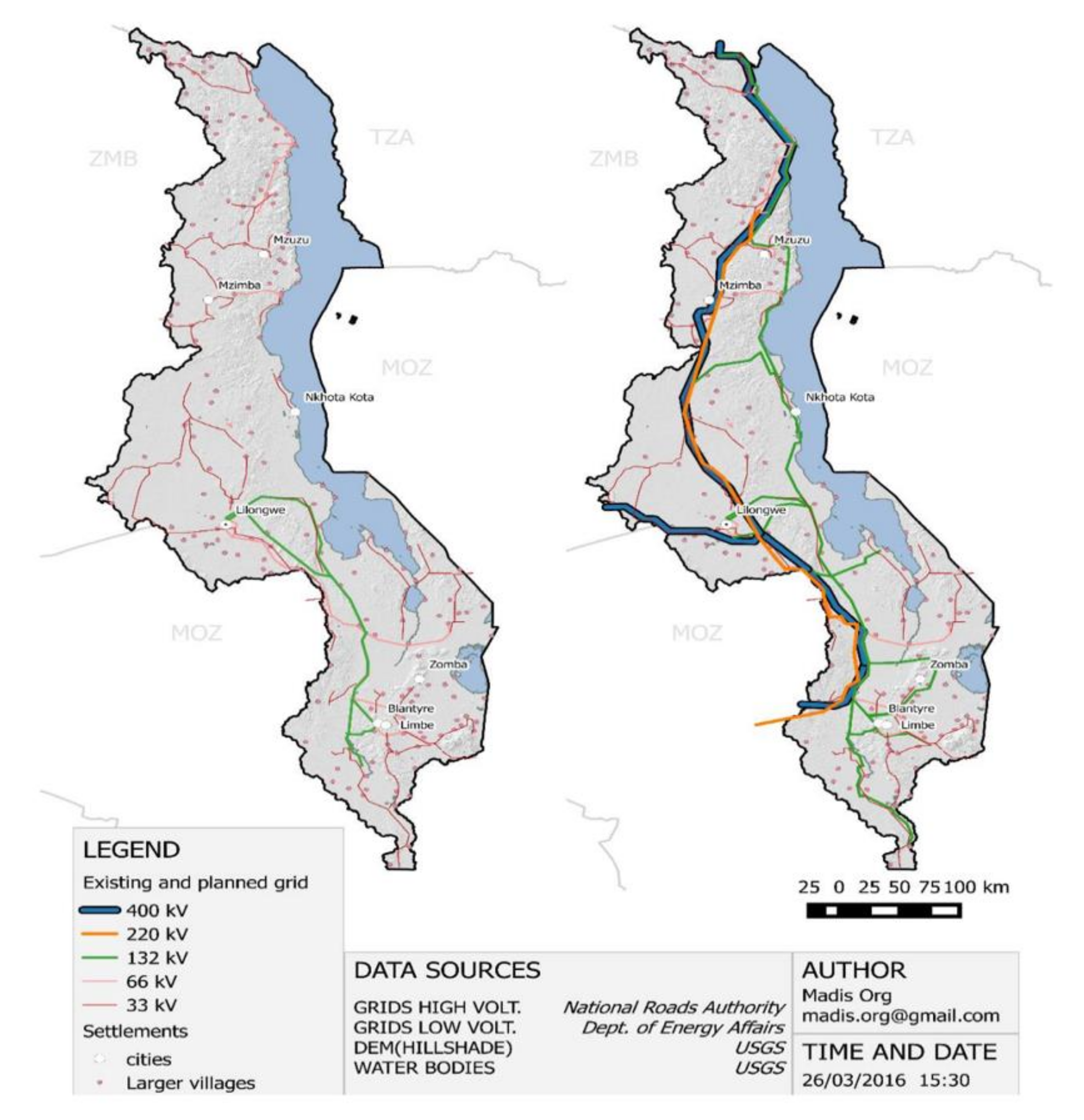
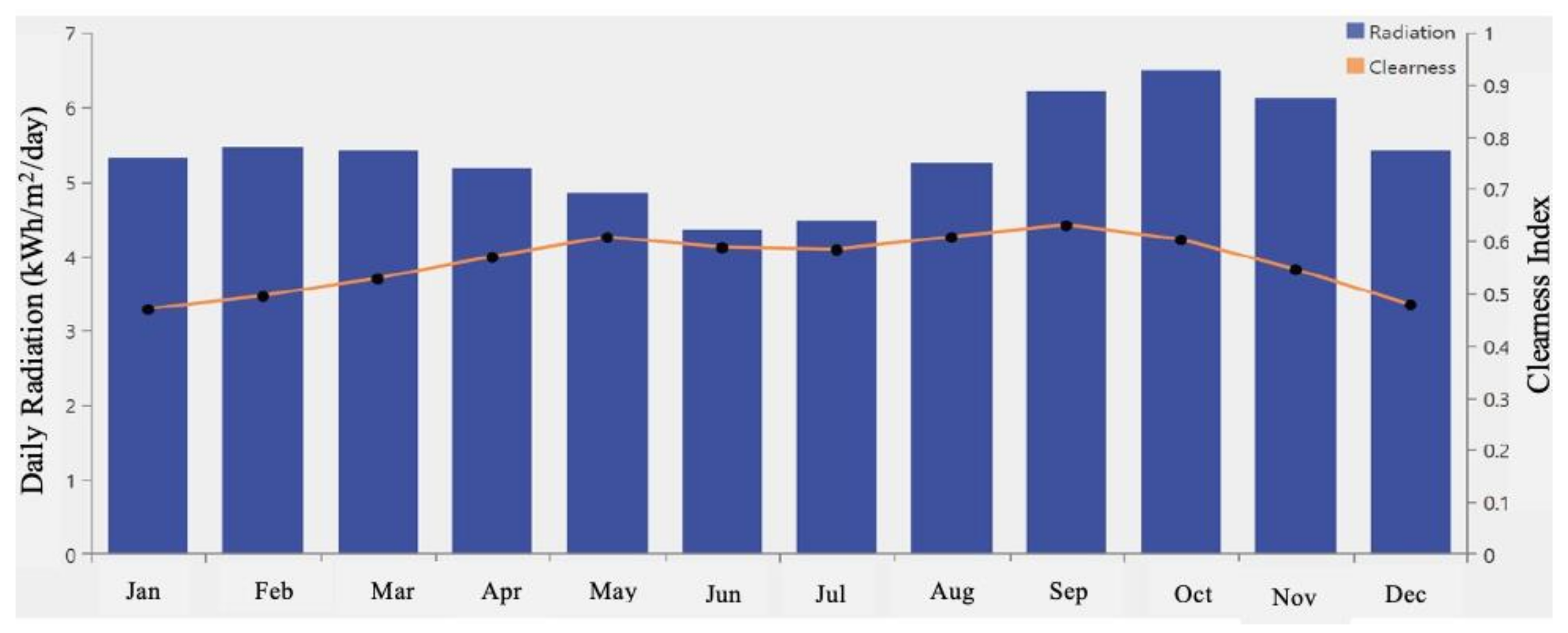
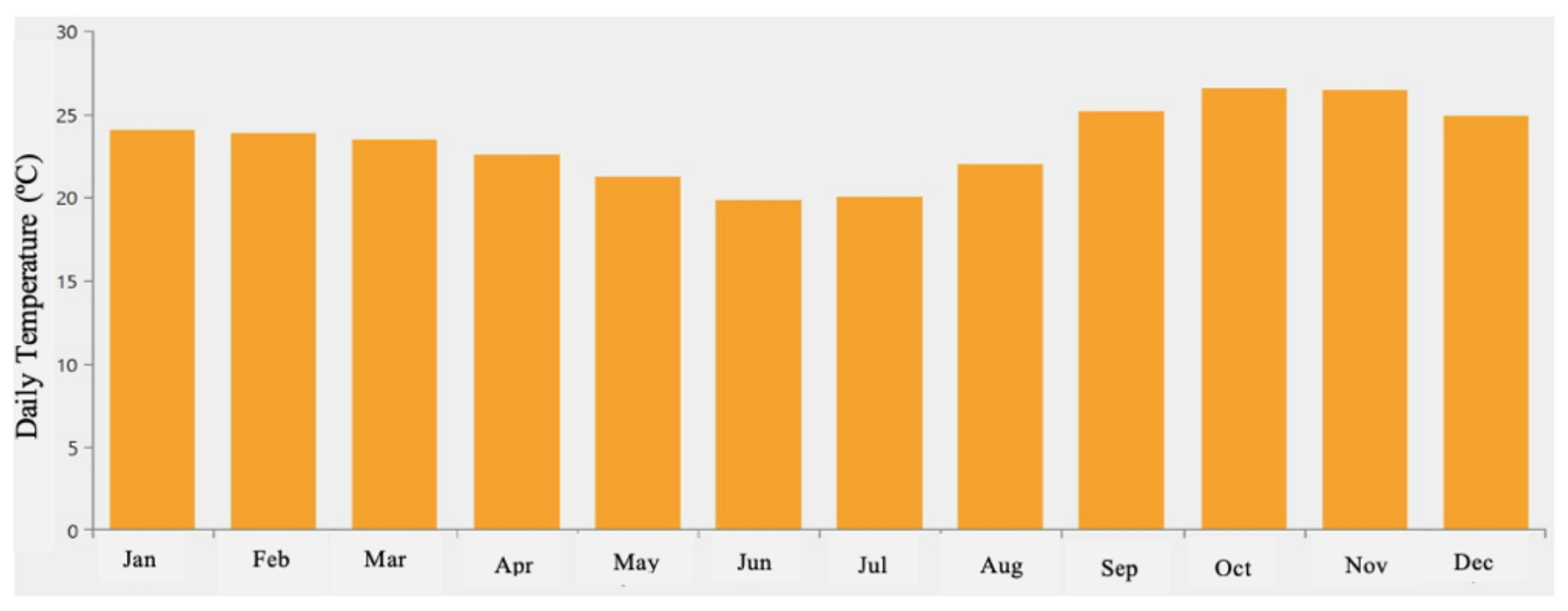

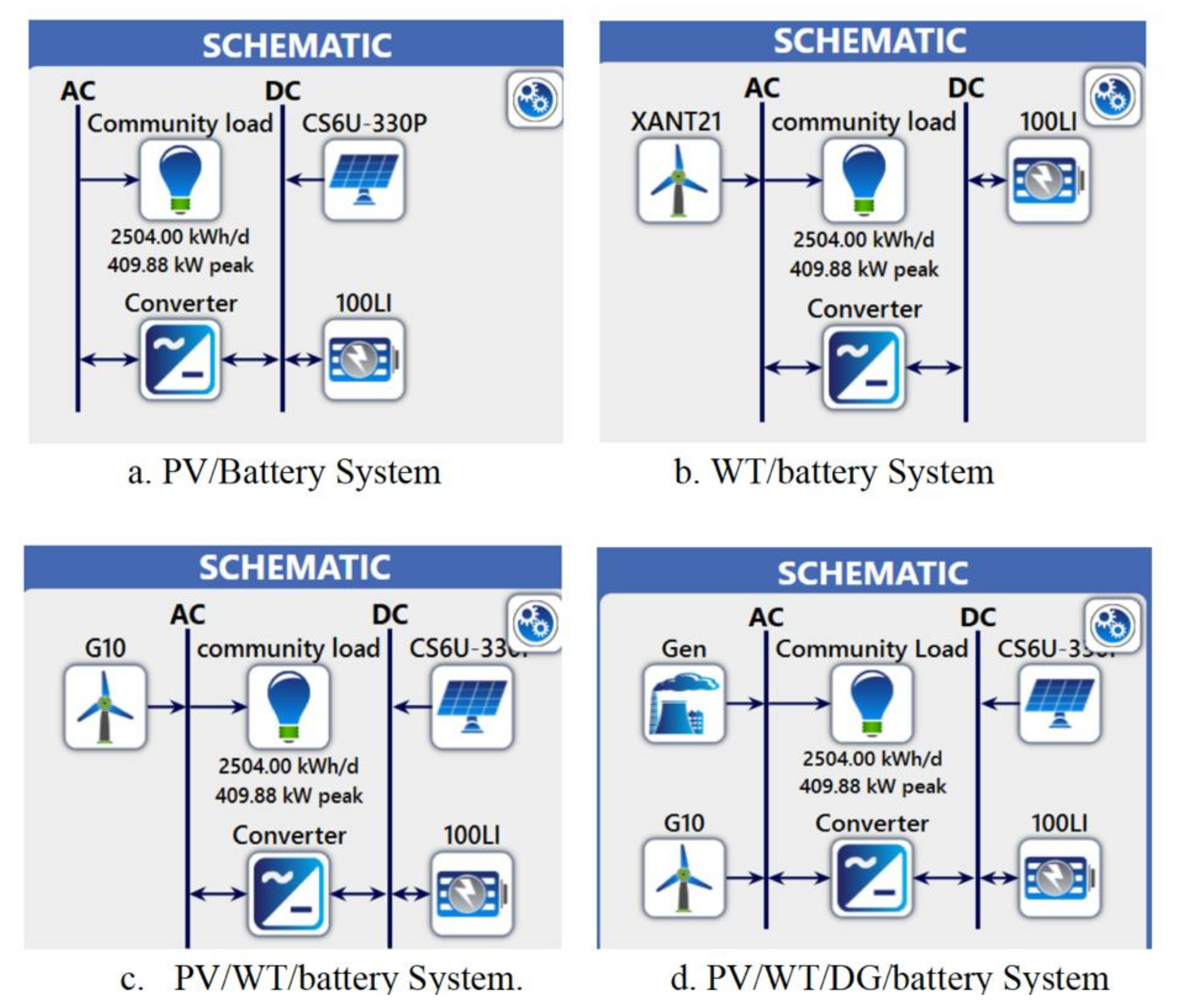


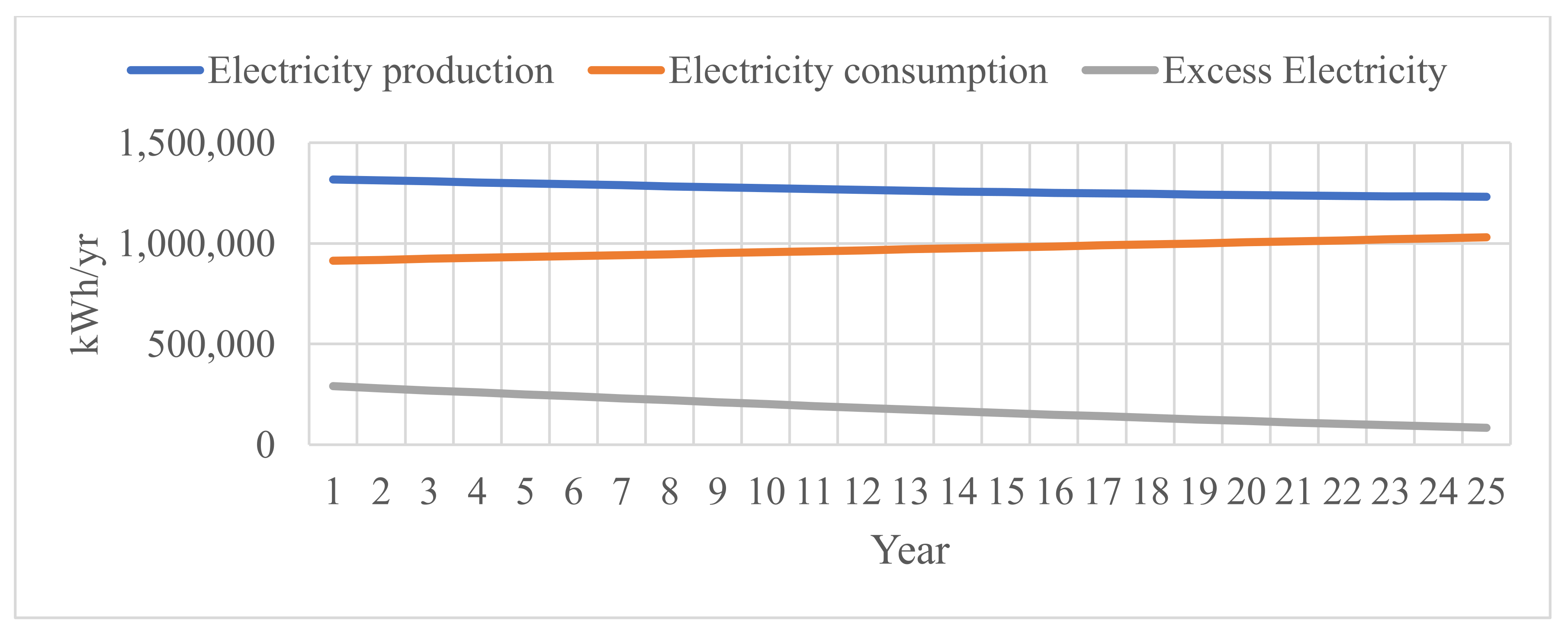
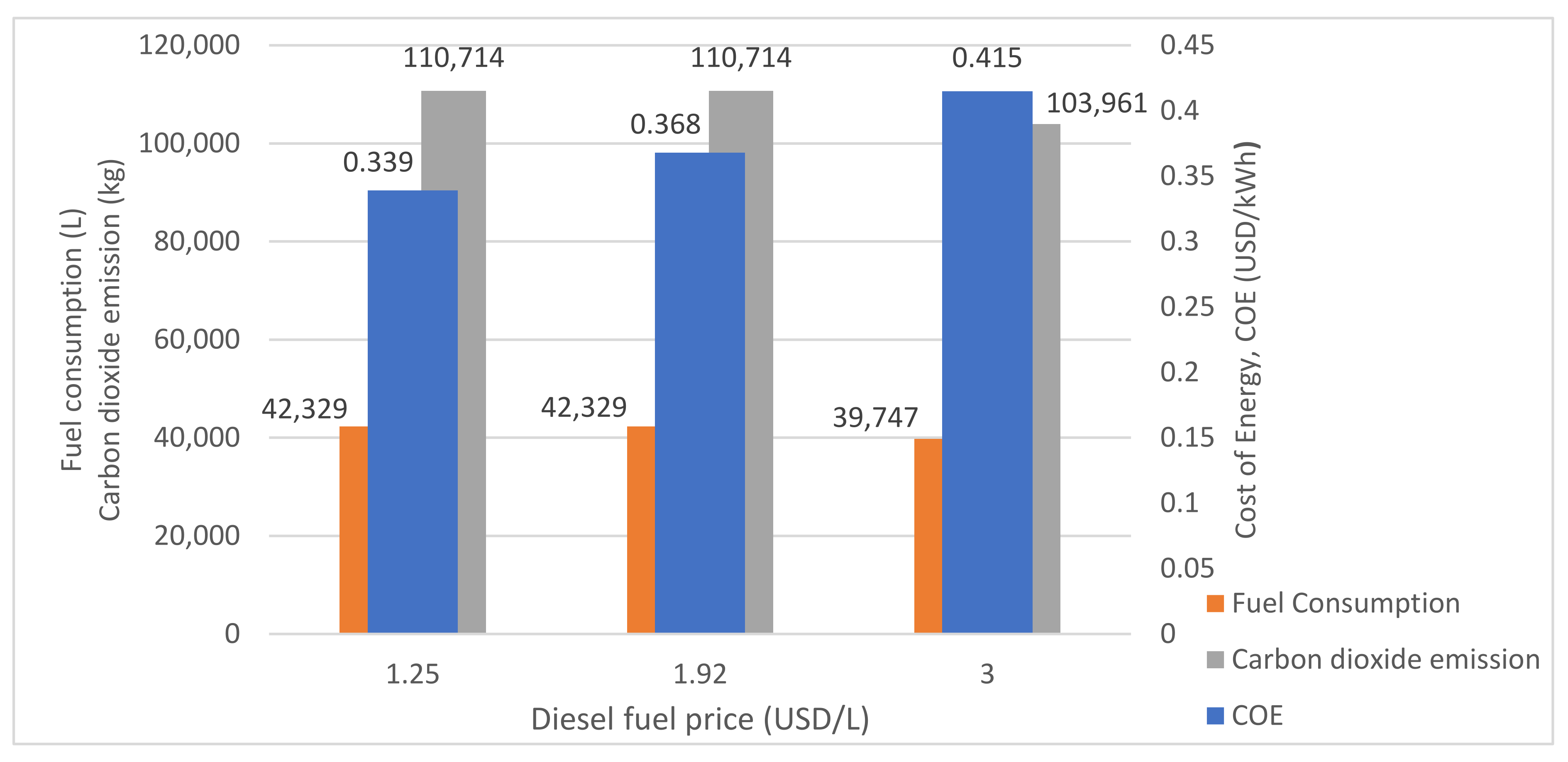
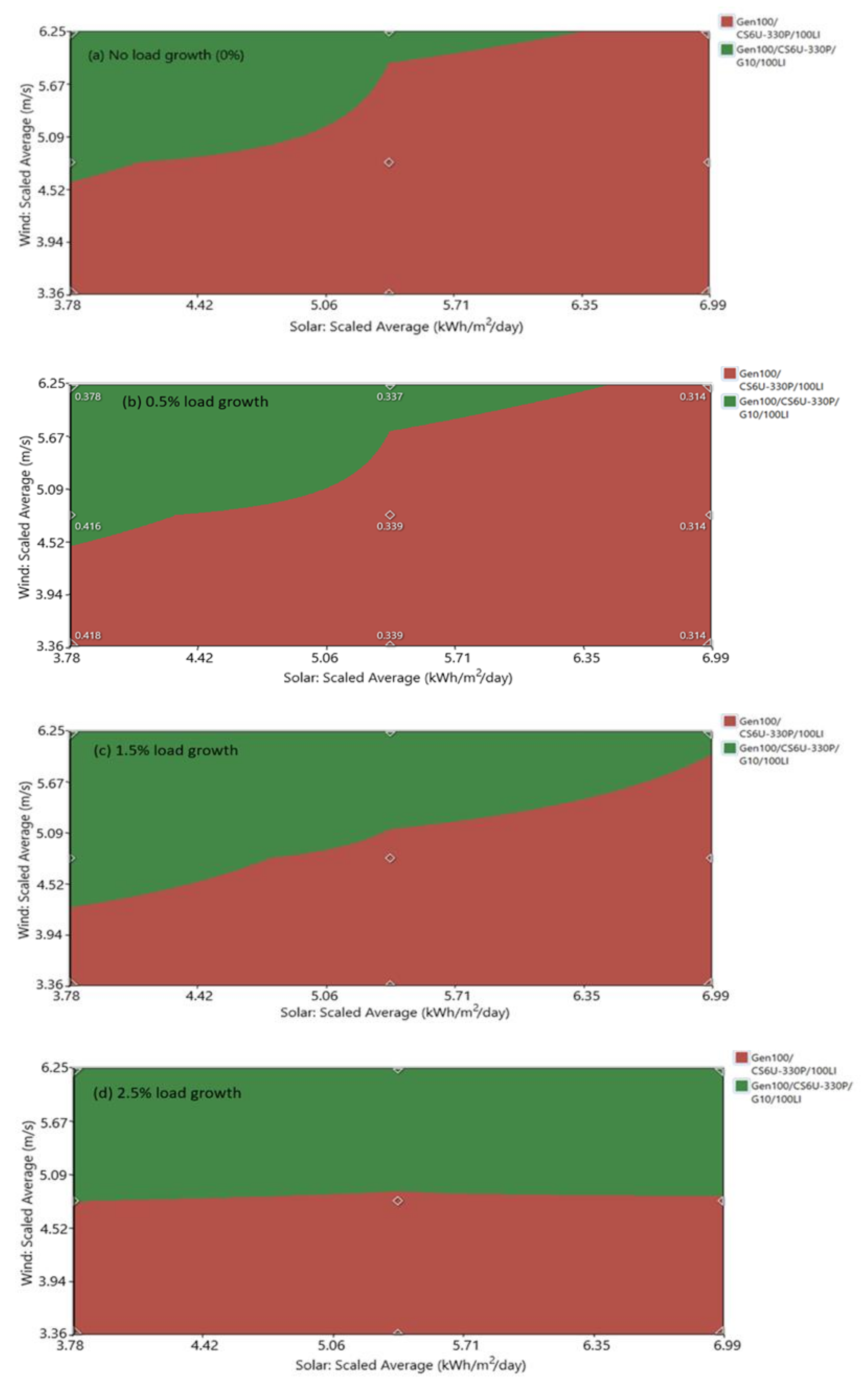
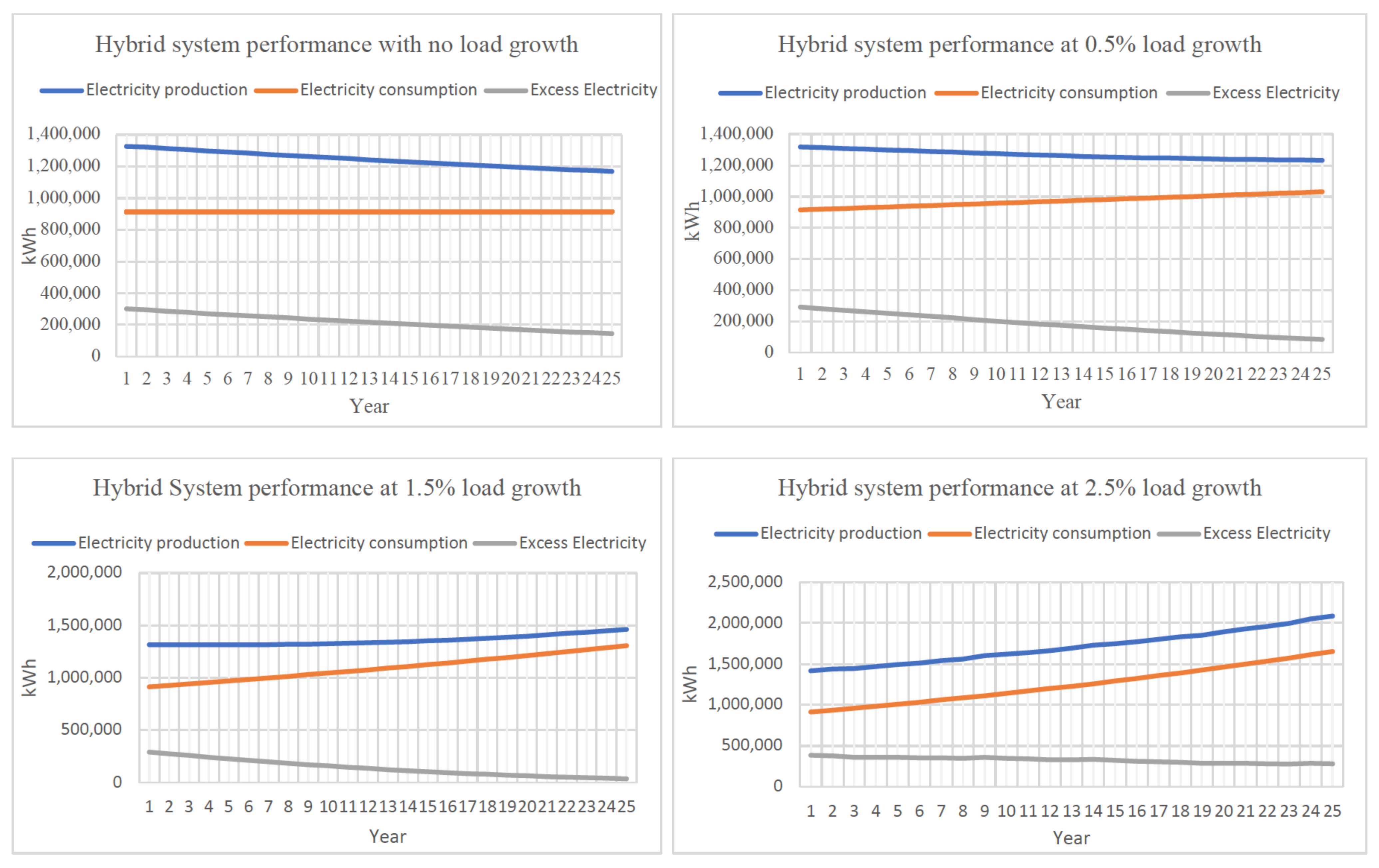
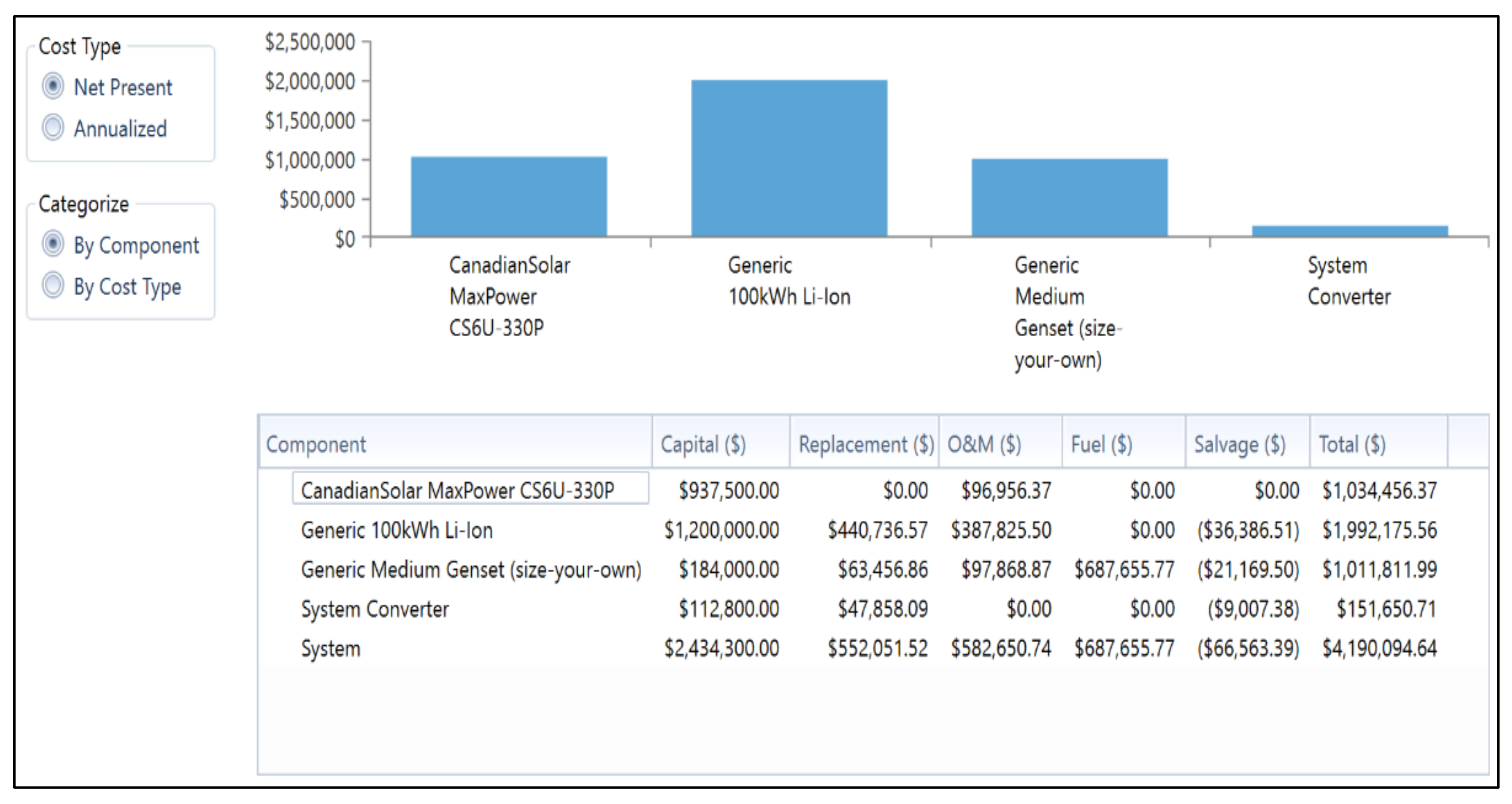
| 2000 | 2005 | 2010 | 2015 | 2018 | |
|---|---|---|---|---|---|
| DR Congo | 6.7% | 7.6% | 8.8% | 8.8% | 8.7% |
| Chad | 2% | 3.5% | 3.7% | 7.7% | 9.2% |
| Burundi | 4% | 4.7% | 5.3% | 9.1% | 10.6% |
| Niger | 7% | 7.8% | 8.6% | 10.7% | 12.6% |
| Malawi | 5% | 7.4% | 8.7% | 10.8% | 14.6% |
| Ghana | 45% | 51.5% | 64.9% | 75.8% | 84.3% |
| South Africa | 77.3% | 78% | 84.4% | 91.8% | 94.9% |
| Component | Parameter | Design Specification |
|---|---|---|
| Solar PV panel | Rated capacity (peak power) | 330 Wp |
| Derating factor | 88% | |
| Efficiency at STC | 16.97% | |
| Temperature coefficient | −0.41 | |
| Manufacturer/type | Canadian solar/Flat plate | |
| Wind turbine | Rated capacity | 10 kW |
| Hub height | 50 m | |
| Diesel generator | Rated capacity | 460 kW |
| Minimum load ratio | 25% | |
| Lifetime | 15,000 h | |
| Battery | Nominal capacity | 100 kWh |
| Nominal capacity | 167 Ah | |
| Nominal coltage | 600 V | |
| Minimum state of charge | 20% | |
| Round trip efficiency | 90% | |
| Converter/Inverter | Efficiency | 95% |
| Total Number of Households = 400 | ||||||
|---|---|---|---|---|---|---|
| Appliance | Qty | Power (W) | Power Per Household (W) | Total Household Power (kW) | Time (h) | Hours/Day |
| Light bulbs | 7 | 20 | 140 | 56 | 06:00–07:00 18:00–22:00 | 5 |
| Sound system | 1 | 50 | 50 | 20 | 17:00–23:00 | 6 |
| Television | 1 | 80 | 80 | 32 | 17:00–22:00 | 5 |
| Electric fan | 2 | 80 | 160 | 64 | 18:00–06:00 12:00–14:00 | 14 |
| Other load | 100 | 100 | 40 | 18:00–20:00 06:00–09:00 | 5 | |
| Total | 530 | 212 | ||||
| Parameter/Component | Unit | System 1 | System 2 | System 3 | System 4 | System 5 |
|---|---|---|---|---|---|---|
| PV Panel | kW | 1546 | 0 | 1670 | 768 | 0 |
| Diesel generator | kW | 0 | 0 | 0 | 460 | 460 |
| Wind turbine | unit | 0 | 15 | 0 | 0 | 0 |
| Converter | kW | 673 | 504 | 426 | 376 | 0 |
| Battery | unit | 47 | 90 | 43 | 28 | 0 |
| Dispatch strategy | CC | CC | CC | LF | CC | |
| Cost of energy | $/kWh | 0.448 | 1.41 | 0.443 | 0.324 | 0.789 |
| Renewable fraction | % | 100 | 100 | 100 | 91.3 | 0 |
| Fuel consumption | L/yr | 0 | 0 | 0 | 23,457 | 364,208 |
Publisher’s Note: MDPI stays neutral with regard to jurisdictional claims in published maps and institutional affiliations. |
© 2021 by the authors. Licensee MDPI, Basel, Switzerland. This article is an open access article distributed under the terms and conditions of the Creative Commons Attribution (CC BY) license (https://creativecommons.org/licenses/by/4.0/).
Share and Cite
Eko, J.O.; Paul, M.C. Integrated Sustainable Energy for Sub-Saharan Africa: A Case Study of Machinga Boma in Malawi. Energies 2021, 14, 6330. https://doi.org/10.3390/en14196330
Eko JO, Paul MC. Integrated Sustainable Energy for Sub-Saharan Africa: A Case Study of Machinga Boma in Malawi. Energies. 2021; 14(19):6330. https://doi.org/10.3390/en14196330
Chicago/Turabian StyleEko, Juliana O., and Manosh C. Paul. 2021. "Integrated Sustainable Energy for Sub-Saharan Africa: A Case Study of Machinga Boma in Malawi" Energies 14, no. 19: 6330. https://doi.org/10.3390/en14196330
APA StyleEko, J. O., & Paul, M. C. (2021). Integrated Sustainable Energy for Sub-Saharan Africa: A Case Study of Machinga Boma in Malawi. Energies, 14(19), 6330. https://doi.org/10.3390/en14196330







